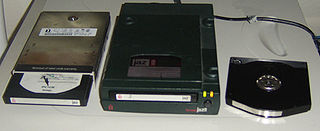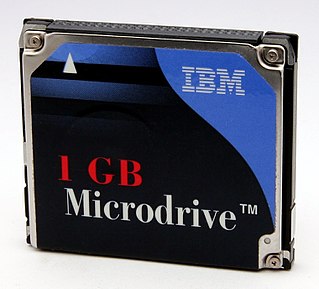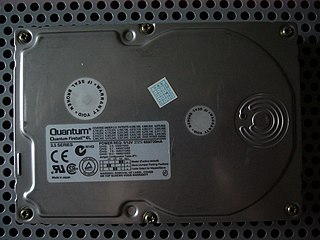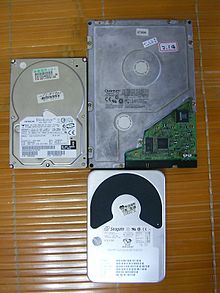
A floppy disk or floppy diskette is an obsolescent type of disk storage composed of a thin and flexible disk of a magnetic storage medium in a square or nearly square plastic enclosure lined with a fabric that removes dust particles from the spinning disk. Floppy disks store digital data which can be read and written when the disk is inserted into a floppy disk drive (FDD) connected to or inside a computer or other device.

A hard disk drive (HDD), hard disk, hard drive, or fixed disk, is an electro-mechanical data storage device that stores and retrieves digital data using magnetic storage with one or more rigid rapidly rotating platters coated with magnetic material. The platters are paired with magnetic heads, usually arranged on a moving actuator arm, which read and write data to the platter surfaces. Data is accessed in a random-access manner, meaning that individual blocks of data can be stored and retrieved in any order. HDDs are a type of non-volatile storage, retaining stored data when powered off. Modern HDDs are typically in the form of a small rectangular box.

A disk read-and-write head is the small part of a disk drive which moves above the disk platter and transforms the platter's magnetic field into electrical current or, vice versa, transforms electrical current into magnetic field. The heads have gone through a number of changes over the years.
Maxtor was an American computer hard disk drive manufacturer. Founded in 1982, it was the third largest hard disk drive manufacturer in the world before being purchased by Seagate in 2006.

Western Digital Corporation is an American computer drive manufacturer and data storage company, headquartered in San Jose, California. It designs, manufactures and sells data technology products, including data storage devices, data center systems and cloud storage services.

Seagate Technology Holdings plc is an American data storage company. It was incorporated in 1978 as Shugart Technology and commenced business in 1979. Since 2010, the company has been incorporated in Dublin, Ireland, with operational headquarters in Fremont, California, United States.

The Jaz drive was a removable hard disk storage system sold by the Iomega company from 1995 to 2002.
IBM manufactured magnetic disk storage devices from 1956 to 2003, when it sold its hard disk drive business to Hitachi. Both the hard disk drive (HDD) and floppy disk drive (FDD) were invented by IBM and as such IBM's employees were responsible for many of the innovations in these products and their technologies. The basic mechanical arrangement of hard disk drives has not changed since the IBM 1301. Disk drive performance and characteristics are measured by the same standards now as they were in the 1950s. Few products in history have enjoyed such spectacular declines in cost and physical size along with equally dramatic improvements in capacity and performance.
Density is a measure of the quantity of information bits that can be stored on a given length of track, area of surface, or in a given volume of a computer storage medium. Generally, higher density is more desirable, for it allows more data to be stored in the same physical space. Density therefore has a direct relationship to storage capacity of a given medium. Density also generally affects the performance within a particular medium, as well as price.

The Western Digital Raptor is a discontinued series of high performance hard disk drives produced by Western Digital first marketed in 2003. The drive occupies a niche in the enthusiast, workstation and small-server market. Traditionally, the majority of servers used hard drives featuring a SCSI interface because of their advantages in both performance and reliability over consumer-level ATA drives.

The Microdrive is a registered trademark for miniature, 1-inch hard disks produced by IBM and Hitachi. These rotational media storage devices were designed to fit in CompactFlash (CF) Type II slots. The release of similar drives by other makers led to them often being referred to as "microdrives" too. By 2010, Microdrives were viewed as obsolete, having been overtaken by solid-state flash media in read/write performance, storage capacity, durability, and price.
Perpendicular recording, also known as conventional magnetic recording (CMR), is a technology for data recording on magnetic media, particularly hard disks. It was first proven advantageous in 1976 by Shun-ichi Iwasaki, then professor of the Tohoku University in Japan, and first commercially implemented in 2005. The first industry-standard demonstration showing unprecedented advantage of PMR over longitudinal magnetic recording (LMR) at nanoscale dimensions was made in 1998 at IBM Almaden Research Center in collaboration with researchers of Data Storage Systems Center (DSSC) – a National Science Foundation (NSF) Engineering Research Center (ERCs) at Carnegie Mellon University (CMU).

The M2351 "Eagle" was a hard disk drive manufactured by Fujitsu with an SMD interface that was used on many servers in the mid-1980s. It offered an unformatted capacity of 470 MB in 10+1⁄2 inches (270 mm) (6U) of 19-inch rack space, at a retail price of about US$10,000.
Mark Howard Kryder was Seagate Corp.'s senior vice president of research and chief technology officer. Kryder holds a Bachelor of Science degree in electrical engineering from Stanford University and a Ph.D. in electrical engineering and physics from the California Institute of Technology.
In 1953, IBM recognized the immediate application for what it termed a "Random Access File" having high capacity and rapid random access at a relatively low cost. After considering technologies such as wire matrices, rod arrays, drums, drum arrays, etc., the engineers at IBM's San Jose California laboratory invented the hard disk drive. The disk drive created a new level in the computer data hierarchy, then termed Random Access Storage but today known as secondary storage, less expensive and slower than main memory but faster and more expensive than tape drives.

A floppy disk is a disk storage medium composed of a disk of thin and flexible magnetic storage medium encased in a rectangular plastic carrier. It is read and written using a floppy disk drive (FDD). Floppy disks were an almost universal data format from the 1970s into the 1990s, used for primary data storage as well as for backup and data transfers between computers.

The Seagate Barracuda is a series of hard disk drives and later solid state drives produced by Seagate Technology that was first introduced in 1993.
Higher performance in hard disk drives comes from devices which have better performance characteristics. These performance characteristics can be grouped into two categories: access time and data transfer time.

The Quantum Fireball was a brand of 3.5-inch hard disk drives made by Quantum Corporation from 1995 to 2001. The first models in the series were 5400 RPM and came in 0.54 and 1.08 GB capacities, while the Quantum Fireball Plus was known for being Quantum's first 7200 RPM Integrated Drive Electronics (IDE) hard drive. There were sixteen different models of the Quantum Fireball, with the last being the LCT 20.













